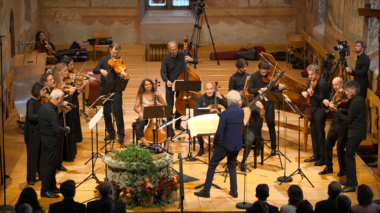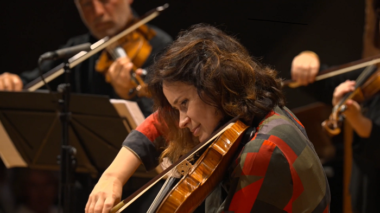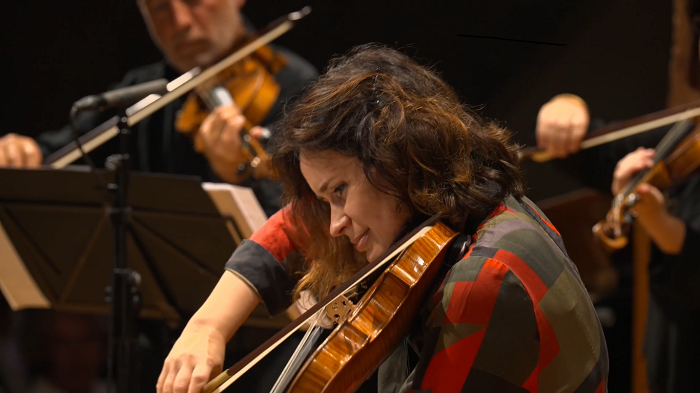 Switzerland Gstaad Menuhin Festival – Vivaldis Tod in Wien: Patricia Kopatchinskaja (violin), Il Giardino Armonico / Giovanni Antonini (recorder/conductor). Saanen Church, 26.8.2022. (CC)
Switzerland Gstaad Menuhin Festival – Vivaldis Tod in Wien: Patricia Kopatchinskaja (violin), Il Giardino Armonico / Giovanni Antonini (recorder/conductor). Saanen Church, 26.8.2022. (CC)

Vivaldi – Concerto for Strings in G minor, RV157; Violin Concerto in C, RV191; Violin Concerto in E flat, RV253, ‘Il tempesta di mare’; ‘Lazzo parlante’; Violin Concerto in D, RV208, ‘Il Grosso Mogul’; Concerto for Strings in E minor, RV550
Enescu – Impressions d’enfance, Op.28
Sciarrino – Capriccio for Solo Violin No.2
Aureliano Cattaneo – Estroso
Sollima – Moghul
This melding of artists at the very top of their game resulted in one of the most memorable concerts to come from Gstaad (Saanen, to be absolutely accurate, a beautiful little church on a hill). This concert certainly comes out of the same forces’ recording on the ever-pioneering Alpha label, What’s Next, Vivaldi?, released in September 2020.
Vivaldi’s Concertos for Strings remain on the periphery of public awareness – the lack of a defined solo instrument when the composer’s most famous work, The Four Seasons, is most certainly for violin and strings. Antonini and Il Giardino Armonico, fierce defenders of Vivaldi (think of their own recording of the Seasons, or their work with Cecilia Bartoli) persuade us that there is real magic in these scores. There was fire galore in the first movement of RV157, but it was in the fragile imitations of an ascending, aspiring line in the second that truly impressed. The care that went into the balancing of chords and textures was everywhere apparent, but it was the prevailing sense of endless energy that impressed, that drew the audience in.
Kopatchinskaja sat at the back of the church, alone, for the first two movements but joined the group for the finale. It was part of a ploy; as out of Vivaldi’s expertly constructed textures, themselves frothing with energy, came a rogue voice, a solo violin who settled into Enescu’s Op.28 Impressions d’enfance. This was a haunting performance indeed. With Kopatchinskaja, it is rarely the sounds alone – a look of mystery into the church rafters after a particularly enigmatic phrase ending, the way she challenged Antonini with a look to begin the Vivaldi after the solo piece’s final gesture. The link was perfect, given the gestural nature of RV191, with a strong opening left to hang in the air before more lyrical slants are explored. Kopatchinskaja’s way with Vivaldi’s highly ornate surfaces, her way with ornamentation, is without parallel. It sounds almost improvised, as it should, but these performers awakened us to the sheer modernity of Vivaldi’s writing, its brazen sense of daring. That sense is just as present in the pared-down textures of the slow movement, where Kopatchinskaja seemed willing to reveal her vulnerability. Melodies hung by a thread; above barely audible throbbings from the ripieno strings, Kopatchinskaja soared before a finale bristled and violinistic fireworks flew.
Another reframing of expectations: from the tuning of the orchestra emerged Sciarrino’s Capriccio No.2 (from a set of six), silvery, and elusive as one might expect from this composer: flautando, ultra-high trills and tremolos. The church amplifies every sound, so some audience noise was to be expected, drowned by the louder virtuosity of Vivaldi’s ‘La tempesta di mare’ Concerto. The way Kopatchinskaja can take Vivaldi and suddenly seem to heighten the music’s modernism is remarkable, and compelling; suddenly the music veers off into a swirl of glissandos or upwards like an out-of-control spiral, with Kopatchinskaja and Antonini at one point heading to the back to play a sheet of metal and a rotating drum that created storm sounds. The juxtapositions were enormous and – tellingly – not contradictory to Vivaldi. This was a storm unheard of in Vivaldi’s time, but when his music returns, it does so naturally. Even the slow movement had its discomfiting elements. And so it should – Vivaldi is not ambient music, Kopatchinskaja and Antonini proved that even a simple arpeggio can have huge emotive force.

In a short speech in German, Kopatchinskaja talked of the commedia dell’arte, a nice bridge to the short ‘Lazzo parlante’, actually an exercise the performers used in the warm-up to their Alpha album. Another daring segue, for it moved straight into Aurliano Cattaneo’s Estroso (‘Whimsical’) for violin, flute, strings, theorbo and harpsichord. The sound of the harpsichord in modern, dissonant sonorities is very telling, a reframing of expectations (given the Vivaldi basis of the programme). At one point the texture thins to recorder (Antonini) and violin duet, with which the piece moves towards a profound silence.
The final two works paired together perfectly: Sicilian composer Giovanni Sollima’s Moghul and Vivaldi’s Concerto, ‘Il grosso Mogul’. Sollima’s piece is markedly evocative, a soulful, high violin singing against a bed of mild dissonance and quasi-improvisatory theorbo, and its use of recorder, its final resolution inviting in Vivaldi’s radiant Concerto in D, RV208. This is a concerto of the highest virtuosity. Even here a destabilising theorbo threatens the hegemony of Vivaldi’s tonal processes; and at times, Kopatchinskaja was like a crazed Vivaldian folk fiddler. The music veered off-piste – like listening to Vivaldi melting – before finding itself again. Kopatchinskaja is an artist like no other: she dares, and when the results work, they are mind-blowing.
Finally, with Kopatchinskaja in the orchestra again, the Concerto for Strings in E minor, RV550.
It is perhaps important to note that what we got was not entirely what was in the programme booklet, something to which I think Patricia Kopatchinskaja referred to in her speech. All part of the adventure. A remarkable evening.
Colin Clarke
You can stream this concert for free here.
